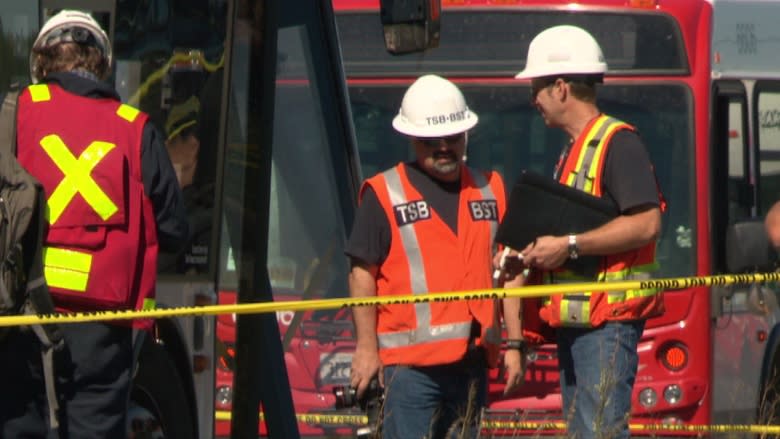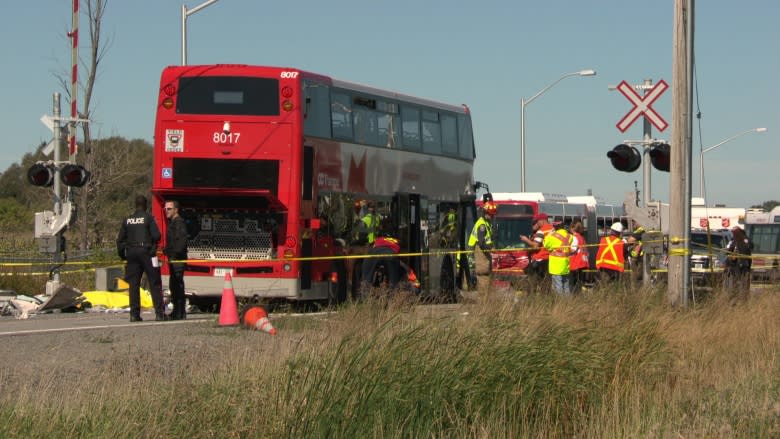Monitors to stay on OC Transpo double-deckers despite federal report
More than three years after an OC Transpo bus crashed into a passenger train in Barrhaven, killing six, some federal recommendations aimed at making Ottawa's fleet of double-deckers less distracting for drivers have not been acted upon.
In a report sent to the city in February, an inspector with the Employment and Social Development Canada's Labour Program wrote that "there are still corrective and preventative measures, employee training and an evaluation program that have yet to be completed."
The report's recommendations include:
- Turning off overhead monitors that give drivers a view of the upper level of double-decker buses, but require them to look up from the road.
- Integrating an advance warning signal at OC Transpo's Fallowfield station with Via Rail's own warning system, to let drivers know when a train is coming toward the Transitway crossing. Currently, the advance light flashes constantly.
- Further training for drivers about assessing potential hazards at level crossings.
Recommendations nothing new, GM says
John Manconi, the city's general manager of transportation, said in an interview that all the issues raised by the Labour Program report are already being addressed.
"I'll be frank — there's nothing new in this report," said Manconi, who added that his department's formal response to the report is expected later this month.
The Transportation Safety Board of Canada investigated the deadly Sept. 18, 2013 crash from its own perspective and delivered its final report at the end of 2015.
The ESDC's Labour Program investigates whenever federal employees are hurt on the job. Because its buses cross a provincial border, OC Transpo is federally regulated.
According to the TSB report, "research has determined that a driver's glances away from the forward visual scene, especially glances lasting two seconds or longer, are significantly associated with accidents and near accidents." Even the city's own consultants, MMM Group, recommended that the monitors be moved to the driver's right-hand side.
Federal inspector wants monitors turned off
But those monitors "remain at a high angle to the left of the driver's view," according to the Labour Program report, written by inspector Michael O'Donnell.
The Labour Program calls for the overhead monitors to be turned off altogether, at least when the double-deckers are in motion, and for an automated announcement and more signs warning passengers that standing on the upper level is prohibited.
The report said there is "a lot of information for an operation of a double-decker to take in … operators are required to monitor passengers on two levels with the assistance of a rear-view mirror to monitor the lower deck and the overhead monitor to monitor the upper level."
Manconi agreed that "there is a lot going on, no doubt about it" for double-decker drivers, but said it wouldn't be safe to leave passengers on the upper level unmonitored.
"If something is occurring, how will the operator know?" Manconi asked.
Following MMM Group's ergonomic study — which was completed in December 2015 — OC Transpo will begin moving the overhead monitors later this month.
"I don't think it's taken too long," said Manconi, adding that moving the overhead monitors is complicated.
As for integrating warning lights at the level crossing, Manconi said the issue was explored by the city and Via a couple of times, but there were technical problems. Because the train is decelerating as it approaches the Transitway and the nearby Barrhaven VIA station, it triggers "false positives" in the early-warning system, which Manconi said would cause confusion among drivers.
Clint Crabtree, the president of the union representing OC Transpo drivers, declined to comment on the Labour Program report, which he confirmed he had seen.
Grade separation report coming
Manconi also disagreed with the Labour Program assessment that there hasn't been enough education of drivers when it comes to railway crossings. He said all drivers have been given more training about assessing risk at the level crossings, and more training on when to look — and when not to look — at the overhead monitors.
"There's a lot going on, no doubt about it," said Manconi. "That's why we did an ergonomics check on all buses."
The TSB recommendations, echoed by the Labour Program, call for the city "to reconsider the need for grade separation at the Woodroffe Avenue, Transitway, and Fallowfield Road level crossings."
The city's own study, completed in December 2014, showed the volumes of traffic at the Barrhaven crossings are far above the levels at which turning level crossings into overpasses or underpasses should be considered.
The city has been working on a "feasibility study" for separated grade crossings for years. That report is expected to be tabled to the transportation committee within months.




